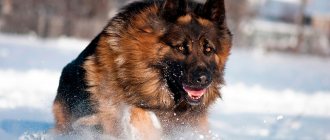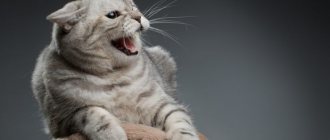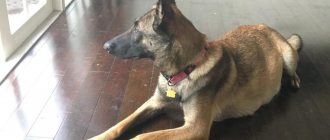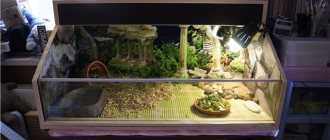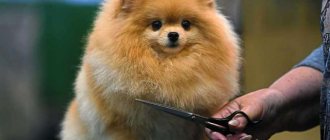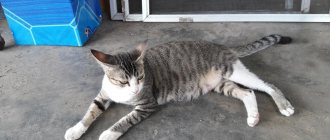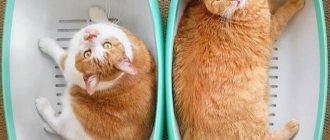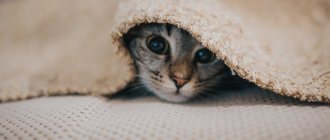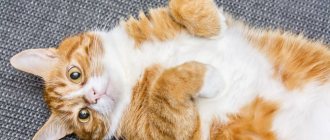The nose of any cat can tell us about the problems or health of a pet. The nose shows us what is happening to the cat at a given time. He is like a thermometer that checks the condition. The first one to take on all the symptoms of disease is the nose. In order to understand illnesses, we must know what kind of nose a healthy cat should have.
How does a cat's nose work?
As we all see, the nose is divided by cartilage into two channels. As the cat inhales air, it enters the nasal chambers. From here the air spreads through winding channels. This is where this Sami air gets trapped and the cat can smell it. From here the information goes to the brain for reading. In these channels, the smell is cleared of impurities so that the smell is clearer. By the way, in order to clear the air of dust, the sinuses heat the air to a certain temperature at which bacteria cannot survive. Air molecules react with cells that recognize odors. From here the olfactory functions come to the center.
Cats have an additional organ - Jacobson's tube. It serves as an odor analyzer that the cat can even taste. It is located above the upper sky. During the analysis, the cat takes on a slightly non-standard expression on its face.
Have you noticed that the nose is soft to the touch, like a pillow? This is the nose. He just tells cat owners that changes are happening to the body.
Diagram of the olfactory organs
The nose of a healthy cat
A healthy cat is a happy cat. Those owners who care about their pet's health often check their beloved cat's nose. But in order to correctly detect the disease, it is important to know which cat’s nose is normal and what deviations there may be.
Other cats have a dry nose as a natural breed characteristic.
Humidity and temperature
The normal temperature for a cat's nose is slightly cold and damp. It is important that the cat's nose does not exceed its body temperature. A cat's body temperature ranges from 38–39 degrees.
The moisture in the nose is maintained by special glands that help recognize odors.
The main thing is to monitor the cat’s body temperature.
Nasal discharge
A healthy cat should not have any nasal discharge. The nasal passages are clean and breathing is free. The fact that a cat's nose is wet does not refer to discharge. It is wet because a special liquid is secreted from the mucous membranes to maintain moisture, and the cat itself often licks its nose. If the nose is already excessively wet, then you can think about the cat’s ailments.
Touch the cat's nose - it should be cold and wet.
Nose color
Basically, the color of the nose will depend on the color of the cat. The nose takes on the same color as the fur near the nose.
Mostly the noses are black and pink. There are gray, purple and brown. The color should be uniform, without pigment spots that were not acquired at birth. But as they grow older, the color darkens a little. There is nothing scary about this.
But the color of the nose does not always convey the truth about the health of the cat.
Why is my nose dry and warm?
A warm nose in cats is explained by an increase in body temperature (hyperthermia) and blood pressure. Such changes are not always explained by diseases - they can be the result of physiological processes.
Norm
Lack of moisture in kittens is associated with inability to maintain hygiene. Babies who do not know how to lick themselves completely rely on their mother cat. If separated from the mother too early, the owner will have to take care of the nose. Without timely moisturizing, it can crack, causing severe discomfort to the small pet.
If the usual activity and appetite are maintained, the cause of a hot nose in a cat may be:
- High activity
. Increased metabolism, necessary for muscle function, contributes to a rise in temperature and loss of fluid.
- Long sleep
. During rest, all internal processes slow down. The work of the mucous glands is no exception. The usual humidity returns some time after waking up.
- Dryness and high indoor temperature
. Under such conditions, the rate of moisture evaporation exceeds the rate of secretion production. That is why it is recommended to keep animals away from heating appliances. A humidifier can also help solve this problem.
- Low fluid intake
. Make sure your pet drinks its daily intake. Lack of water can lead to dehydration.
- Stress
. An animal's excitement is accompanied by behavioral changes: aggression, unsociability. When under stress, the cat will avoid communication and lick itself frequently. Knowing the cause of his worries, you need to try to eliminate it or use sedatives recommended by the veterinarian.
- Estrus
. This period is easy to recognize by loud songs, excessive affection and a characteristic posture.
Measuring body temperature using the lobe is not always accurate, since the owner is guided by his own feelings. If the pet’s condition does not return to normal, take a measurement with a rectal thermometer.
Dangerous reasons
If none of the physiological reasons are suitable, then a hot nose in a cat may indicate the presence of an illness. It can be identified by accompanying symptoms, but only a doctor can make an accurate diagnosis.
Diseases accompanied by hyperthermia include:
- neoplasms and foreign bodies stuck in the sinuses;
- injuries that prevent secretion production;
- diseases of the urinary system;
- rhinitis and sinusitis;
- inflammation and infections;
- trichobezoars that have clogged the stomach or intestines;
- helminthiases;
- poisoning and gastrointestinal disorders associated with overeating;
- tick infestations.
If you suspect any of the listed pathologies, it is recommended to immediately contact a veterinary clinic. The sooner the cause of the illness is detected, the less likely complications will arise.
What kind of nose should a kitten have?
The kitten's nose will be the same as that of an adult cat - slightly cold, wet, smooth.
But in kittens, the body temperature is slightly higher than adults, so the nose will be a couple of degrees warmer than usual. This is due to the fact that heat exchange in the channels is only developing. And the color of the nose changes with age, so expect that in the future, the color of the kitten's nose will be a shade darker than it is now.
Since kittens are playful and extremely active, their nose will often be dry. Don't worry, this is a normal condition.
Kittens are more susceptible to diseases.
Color change
The color of the nasal mirror can also be used to judge the condition of the pet. In cats with white coat color, the nose is depegmented. A pale nose can serve as an indicator of anemia; a blue nose indicates a low ambient temperature or a disease of the cardiovascular system.
It has been noticed that with age, the color of the nose can change - it becomes darker. The color of the nasal mirror is also affected by the temperature in the room. It has been established that if a cat stays in an apartment for a long time, where the temperature is low, then the color of the coat and the color of the nasal planum darken.
With liver disease, the color of the nasal tissue turns yellow. This is clearly noticeable in white cats. For representatives with dark fur and a dark nose, the doctor checks the color of the mucous membranes of the lips and the sclera of the eyes. A swollen, reddened nose is observed with:
- runny nose;
- high blood pressure;
- allergic reaction;
- viral infection;
- damage;
- increase in body temperature.
Non-critical anomalies
A healthy cat may also experience changes to its nose, but this does not mean that something terrible is happening unless it is accompanied by additional symptoms.
- Dream. During deep sleep, your pet's nose warms up and becomes dry. After the pet wakes up, the nose will remain dry for some time.
- Low humidity in the room or heat. Dry air also makes your pet's nose dry. A humidifier will help cope with this.
- Activity. After playing or running around, the spout heats up.
- Stress. The pet's excitement causes fear, and fear clogs some glands, causing the nose to become dry and hot.
- Age. In older individuals, the nose no longer performs its main function, so the nose dries out.
- Nutrition. Overeating or undereating is a consequence of problems in the body; the nose becomes hot.
- Hairballs. Some cats suffer with them for a long time because they cannot empty their stomachs of them.
All these symptoms go away on their own over time. Of course, if other symptoms also appear, you should think twice and take your pet to the doctor.
Monitor your pet's condition and daily routine.
Do I need to take care of my nose?
The cat takes care of its nose: licks it if it becomes dry on a hot day, washes it with its tongue and paws if it becomes dirty after a walk or sniffing objects. But it is important for the owner to periodically examine and feel the pet’s nose in order to notice suspicious symptoms in time. This is done by lightly touching the back of your hand. A healthy olfactory organ should be slightly moist, cool and shiny, smooth and without flaking. But even this option does not guarantee the health of the animal. Loss of smell for a cat, especially at an early age, is tantamount to the threat of death, since it loses orientation in space and may refuse to eat. Therefore, it is important to be especially attentive and monitor the general well-being of your pet.
You can also contact our site's staff veterinarian, who will respond to them as soon as possible in the comment box below.
Reason to worry
If you notice any ailments, check the symptoms.
- If a cat begins to frequently wash its face with its paws, rubs its nose and eyes, and discharge occurs, there are clear signs of an allergy.
- Ulcers, spots, and crusts appeared on the nose - signs of dermatological diseases.
- Sneezing and a wet, dry nose indicate a cold.
- Hot ears and lips, as well as the color of the nose indicate an increase in temperature. A blue nose indicates hypothermia. Severe pallor indicates anemia and dehydration. Red nose - oxygen starvation, allergies or rhinitis.
- Vomiting and diarrhea indicate a more serious illness - poisoning.
- Apathy, loss of appetite, sleep disturbance indicate the presence of a disease.
First, you should measure the cat's body temperature, but not everyone has a special thermometer for animals, and not everyone is able to measure the temperature. Therefore, when various symptoms appear, veterinarian intervention is required.
The doctor can find possible causes of diseases based on symptoms. Commonly encountered diseases include:
- Rhinitis is a cold.
- Sinusitis.
- Allergic reactions.
- Infections.
- Worms.
- Injuries to the nasal canals and palate.
Also, after castration or sterilization, the pet’s nose may become hot during the day. This reaction is normal, because drugs that are administered to animals as anesthesia block the glands that regulate nasal circulation. In order not to panic, monitor your pet for 24 hours. If the situation does not improve after a couple of days, you should think about it.
Pay attention to the nose and the fur around it.
Diagnosis and treatment
If a cat has a white or bluish nose, then there is a suspicion of anemia or cardiac pathology. A red nose may indicate injury. To identify the cause, the veterinarian listens to complaints, conducts an external examination and prescribes diagnostic procedures, depending on the preliminary diagnosis, such as:
- radiography;
- ECG;
- blood chemistry;
- scraping scales from the skin to test for fungus;
- analysis of ear discharge to detect ticks;
- polymerase chain reaction to detect herpes virus.
Cat noses are treated depending on the disease. Rhinotracheitis is incurable, but an acute attack can be treated with antibiotics or antiviral drugs, which are individually prescribed by a veterinarian. For injuries, rhinoplasty is performed or anti-inflammatory drugs are used. Special drops are prescribed against fungus or ear mites. With necrosis, dead particles are eliminated.
How to examine a cat's nasal cavity
This is done exclusively by a veterinarian who uses special testing tools. The examination is carried out only under anesthesia so that the cat does not feel pain or discomfort.
Also, to measure temperature, the doctor inserts a thermometer into the anus - this is how the pet’s body temperature is measured.
The doctor will carry out procedures, identify important deviations and prescribe the correct treatment. Some procedures will have to be carried out exclusively with a doctor, some the veterinarian will show you, and you will treat the cat at home.
The help of a doctor will never hurt, because he will correctly diagnose and prescribe the right medications.

